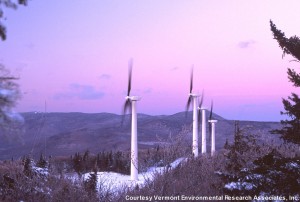By George Harvey
Since our October issue appeared, the news has brought a few surprises. One of them was about Ian Dunlop, who had been a Shell executive for decades and chairman of the Australian Coal Association. He is running for the board of BHP Billiton, the world’s largest mining company, as an outsider. It seems Mr. Dunlop had seen the hand writing on the wall, both for global warming and for the fossil fuels industry. He has jumped ship and become a climate activist. And he believes the BHP Billiton board needs a climate activist.
He has accused the fossil fuel industry of “stuffing up” effective action on climate change. It seems they are using every conceivable means to prevent action, because any effective change will decrease their profits. That being the case, it should be no surprise that every form of renewable power has its activist opponents, ultimately powered by the fossil fuel industry.
Perhaps one of the most pernicious elements of opposition to windpower is the pseudo-environmentalist view that preventing wind turbines from being installed will preserve hilltop habitats. It will not preserve them, because it cannot preserve them.
The Vermont Agency of Natural Resources has a series of papers on climate change. One of them, Climate Change and Vermont’s Forests, speaks of our upland fir and spruce groves; our northern hardwood forests of maple, birch, and beech; our stands of hemlock; and our numerous species of ash trees in these words, “These forests are expected to be nearly eliminated in Vermont…” (anr.state.vt.us/anr/climatechange/Pubs/VTCCAdaptForestry.pdf)

Searsburg, Wind Farm in Vermont. Pictured are 4 or the 11 550-kW turbines.The 6 MW farm produces enough electricity to supply 1600 average VT households.
I am reminded of Michael Landon, star of Bonanza and Little House on the Prairie. In 1991, he told the press that he had been diagnosed with pancreatic cancer, and had been given less than a 1% chance of having it go into remission. He said he would beat it, however, because his fundamental health was good, a point he proved by doing a number of pushups. He did look to be in good health, but less than three months later he was dead.
The state of most of the forests in New England is much like that of Michael Landon in his terminal illness. They may look good, but we cannot save them from climate change. It takes a long time to heat up a planet, and even if we stopped pushing out carbon emissions today, changes will continue for another twenty years. But we are not stopping emissions. We are not even slowing down. We are only beginning to stop accelerating. And for the forests, it is almost certainly too late already.
Even if we act to do the best we can, the habitats will be radically altered. Nevertheless, we must do the best we can. If we stop emitting the green house gasses as soon as possible, we cannot keep the forests we have, but we can have different, beautiful forests. We may not prevent the loss of our fall colors, maple sugar, ski resorts, or even our apple orchards. But we can have lovely green mountains, and the fall colors can be restored with new species imported from places like North Carolina. Our children, and their children cannot have our New England, but they can have a New England they can cherish, and they may even live healthier lives than we do.
It is, of course, not just a matter of environmental habitats being used to oppose wind. Every environmental response is under attack. Science and economics, however, support very few points of opposition, and nearly none relating to windpower.
To stop climate change, we have to stop using fossil fuels. To stop using fossil fuels, we have to use the other resources we have. The problem is not windpower. It is climate change. Windpower is something we need to stop climate change.








Leave a Reply